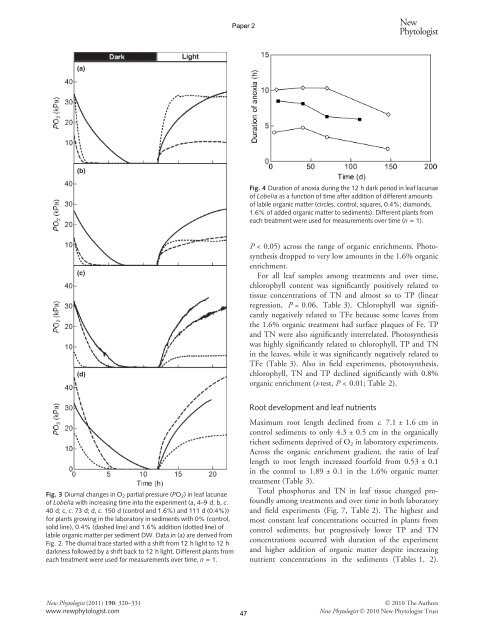Oxygen dynamics and plant-sediment interactions in isoetid ...
Oxygen dynamics and plant-sediment interactions in isoetid ...
Oxygen dynamics and plant-sediment interactions in isoetid ...
You also want an ePaper? Increase the reach of your titles
YUMPU automatically turns print PDFs into web optimized ePapers that Google loves.
326 ResearchPaper 2NewPhytologist(a)(b)Fig. 4 Duration of anoxia dur<strong>in</strong>g the 12 h dark period <strong>in</strong> leaf lacunaeof Lobelia as a function of time after addition of different amountsof labile organic matter (circles, control; squares, 0.4%; diamonds,1.6% of added organic matter to <strong>sediment</strong>s). Different <strong>plant</strong>s fromeach treatment were used for measurements over time (n = 1).(c)(d)P < 0.05) across the range of organic enrichments. Photosynthesisdropped to very low amounts <strong>in</strong> the 1.6% organicenrichment.For all leaf samples among treatments <strong>and</strong> over time,chlorophyll content was significantly positively related totissue concentrations of TN <strong>and</strong> almost so to TP (l<strong>in</strong>earregression, P = 0.06, Table 3). Chlorophyll was significantlynegatively related to TFe because some leaves fromthe 1.6% organic treatment had surface plaques of Fe. TP<strong>and</strong> TN were also significantly <strong>in</strong>terrelated. Photosynthesiswas highly significantly related to chlorophyll, TP <strong>and</strong> TN<strong>in</strong> the leaves, while it was significantly negatively related toTFe (Table 3). Also <strong>in</strong> field experiments, photosynthesis,chlorophyll, TN <strong>and</strong> TP decl<strong>in</strong>ed significantly with 0.8%organic enrichment (t-test, P < 0.01; Table 2).Fig. 3 Diurnal changes <strong>in</strong> O 2 partial pressure (PO 2 ) <strong>in</strong> leaf lacunaeof Lobelia with <strong>in</strong>creas<strong>in</strong>g time <strong>in</strong>to the experiment (a, 4–9 d; b, c.40 d; c, c.73d;d,c. 150 d (control <strong>and</strong> 1.6%) <strong>and</strong> 111 d (0.4%))for <strong>plant</strong>s grow<strong>in</strong>g <strong>in</strong> the laboratory <strong>in</strong> <strong>sediment</strong>s with 0% (control,solid l<strong>in</strong>e), 0.4% (dashed l<strong>in</strong>e) <strong>and</strong> 1.6% addition (dotted l<strong>in</strong>e) oflabile organic matter per <strong>sediment</strong> DW. Data <strong>in</strong> (a) are derived fromFig. 2. The diurnal trace started with a shift from 12 h light to 12 hdarkness followed by a shift back to 12 h light. Different <strong>plant</strong>s fromeach treatment were used for measurements over time, n =1.Root development <strong>and</strong> leaf nutrientsMaximum root length decl<strong>in</strong>ed from c. 7.1 ± 1.6 cm <strong>in</strong>control <strong>sediment</strong>s to only 4.3 ± 0.5 cm <strong>in</strong> the organicallyrichest <strong>sediment</strong>s deprived of O 2 <strong>in</strong> laboratory experiments.Across the organic enrichment gradient, the ratio of leaflength to root length <strong>in</strong>creased fourfold from 0.53 ± 0.1<strong>in</strong> the control to 1.89 ± 0.1 <strong>in</strong> the 1.6% organic mattertreatment (Table 3).Total phosphorus <strong>and</strong> TN <strong>in</strong> leaf tissue changed profoundlyamong treatments <strong>and</strong> over time <strong>in</strong> both laboratory<strong>and</strong> field experiments (Fig. 7, Table 2). The highest <strong>and</strong>most constant leaf concentrations occurred <strong>in</strong> <strong>plant</strong>s fromcontrol <strong>sediment</strong>s, but progressively lower TP <strong>and</strong> TNconcentrations occurred with duration of the experiment<strong>and</strong> higher addition of organic matter despite <strong>in</strong>creas<strong>in</strong>gnutrient concentrations <strong>in</strong> the <strong>sediment</strong>s (Tables 1, 2).New Phytologist (2011) 190: 320–331www.newphytologist.com47Ó 2010 The AuthorsNew Phytologist Ó 2010 New Phytologist Trust
















